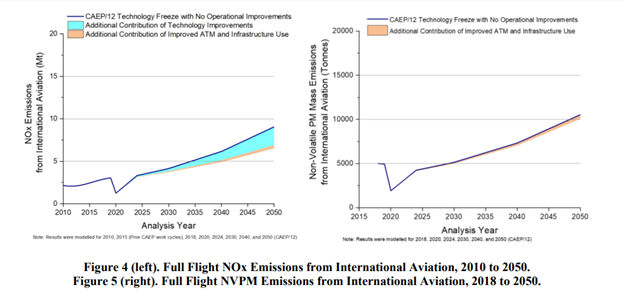Trends in Emissions that affect Climate Change
The first ICAO Global Environmental Trends were presented and endorsed at the 37th Session of the Assembly, and since then the updated global environment trends have been developed and presented to every Assembly Session to form the basis for their considerations and decisions.
The most recent environmental trends are based on data from the latest CAEP/12 air travel mid demand forecast. The forecast utilized a base year of 2018 and future years of 2019, 2020, 2024, 2030, 2040, and 2050. COVID-19 forecast scenarios were developed to capture the possible trajectories of the aviation industry as it moves out of the pandemic-driven downturn.
In 2018, approximately 65% of global aviation fuel consumption was from international aviation. According to the CAEP/12 traffic demand forecast, this proportion is expected to remain relatively stable out to 2050.
The trends presented here were developed in the context of a longer-term view, assuming no airport infrastructure or airspace operational constraints. However, these trends may be substantially impacted by a wide range of factors, including fluctuations in fuel prices, uptake of alternative jet fuels (AJF), and global economic conditions, including the COVID-19 recovery.
Traffic Demand Forecasts and COVID-19
The CAEP/12 environmental trends traffic demand forecast has a 2018 base year and 32-year forecast horizon through 2050. The outbreak of COVID-19 in early 2020 meant that the normal forecast development process had to be altered to account for the near- and long-term effects of the pandemic on the global economy and commercial aviation. Acknowledging the uncertainty surrounding the economic effects of the pandemic, a series of COVID19 traffic demand forecast scenarios were developed to represent a plausible range of recoveries for the aviation industry.
Trends in Aircraft Fuel Burn and CO2 Emissions
The green-house gas (GHG) portion of the trends assessment evaluated potential contributions of operational and technology improvements to reducing projected fuel demand and associated future emissions, focusing on combustion CO2 emissions. The results are based on the 2018- 2050 post-COVID traffic and fleet forecast, representing conventional fuel consumption, CO2 emissions (i.e., CO2 emitted during flight only), and NOx and nvPM emissions. The results contain the alternative fuel analyses, including the potential contribution of alternative jet fuel (AJF) on CO2 net life-cycle emissions.
As shown in Figures 1 and 2, for the year 2050 and for the IEIR (Independent Expert Integrated Review) technology with high operational improvements scenario (Fuel Scenario 4), conventional fuel burn from international aviation, aircraft technology results in a reduction of 112 MT and operations provides an additional 22 MT for a total reduction of 134 MT. Fuel Scenario 1 value for international is 493 MT. ICAO’s 2% aspirational goal for international aviation fuel burn is not achieved, and the average fuel efficiency (2010-2050) is 1.53% which is slightly improved from the 1.37% computed in previous trends assessment for the same time period. Overall, technology and operational improvements results in roughly a 27% reduction in fuel burn for international aviation in 2050 for the IEIR scenario. The most aggressive fuel burn technology improvement scenario is that defined by the CAEP/11 IEIR process.

As shown in Figure 3, in the year 2050 with alternative fuels replacement, in addition to the 27% reduction in CO2 provided by technology and operations, alternative jet fuels replacement provides an additional 56% reduction in net life-cycle CO2.

Trends in Aircraft Full-Flight NOx and nvPM Emissions
With technology and operational improvements (NOx Scenario 3), there is a combined reduction of 2.56 MT and 4.1 MT for international and global aviation, respectively. This amounts to roughly a 28% reduction in NOx from NOx Scenario 1 (technology freeze with no operational improvements), as presented on Figure 4.nvPM Scenario 2 results in 465 tonnes and 895 tonnes reduction of nvPM mass emissions for international and global aviation, respectively. This amounts to roughly 5% reduction from nvPM Scenario 1 (technology freeze with no operational improvements), as presented on Figure 5.
